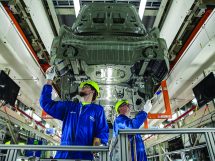
LEXINGTON, Ky. — Researchers at the University of Kentucky Center for Applied Energy Research (CAER) have developed a method to turn Kentucky waste coal into valuable carbon products.
Kentucky is the seventh-largest coal-producing state in the nation, mining millions of tons each year. After mining, coal is sent to a preparation plant, sized and separated for shipment. As part of that process, waste coal, a stream of coal unsuitable for transportation, is produced and stored onsite. Over four billion tons of waste coal are estimated to exist across all Kentucky coalfields.
The technology employed at CAER shows great promise for building a cost-competitive, domestic supply chain for carbon fiber and graphite. These strategic materials are increasingly important to our global economy.
CAER researchers could take what is an environmental liability — impounded waste coal — and turn it into a highly sought-after strategic material critical to the nation’s transportation, national security and renewable energy sectors.
“The University of Kentucky is constantly making waves in the scientific field, whether it’s advancements in energy, agriculture or defense. Today’s exciting breakthrough is a testament to the incredible work the UK CAER research team has done as they revolutionize how coal is used. This is not only fantastic news for the university but also a big win for the thousands of coal workers whose livelihoods depend on Kentucky’s strong coal industry. As Senate Republican Leader, I’m proud to have been a partner in our Commonwealth’s research endeavors, and I’m eager to see how this talented team will build off of this progress,” said U.S. Sen. Mitch McConnell, who has worked closely with UK to support this project.
This CAER research was supported by the U.S. Department of Energy (DOE) Fossil Energy and Carbon Management Office in collaboration with Oak Ridge National Laboratory.
The “C4WARD: Coal Conversion for Carbon Fibers and Composites” project focuses on developing the fundamental and translational science and engineering necessary to create energy-efficient and cost-effective processes for manufacturing carbon fibers and graphite from coal with tunable properties.
A key technical advancement was developing a viable process to convert coal to a filtered liquid and then convert that liquid into mesophase pitch. This liquid crystal material can be converted to highly ordered carbon fiber with high stiffness. It can similarly be used to produce graphite powders.
In this breakthrough, high-modulus carbon fibers were produced from the waste coal, meaning they have a high stiffness-to-weight ratio. Nearly half of the carbon comprising the fibers stemmed from coal waste.
“Carbon fiber and graphite are essential to any energy transition,” said Rodney Andrews, CAER director and principal investigator for C4WARD. “We believe this technology has a real opportunity to create new jobs and boost economic opportunities in Kentucky coal communities as demand for carbon fiber and graphite continues to grow.”
This project was spearheaded by CAER’s Carbon Materials Group, guided by Andrews and CAER Associate Director Matthew Weisenberger. CAER is a global leader in developing carbon fiber from various sources and is home to the largest carbon fiber spinline facility at any academic institution in North America.
The C4WARD project is the convergence of two of the university’s priority initiatives, challenging Kentucky’s top researchers to focus on the Commonwealth’s most pressing issues. This project is crucial to UK’s existing Energy Research Priority Area and UK’s newly created Materials Science Research Priority Area (RPA). The RPA aims to find innovative solutions to address industry challenges and position the Commonwealth to become a global leader in a competitive materials market.



















